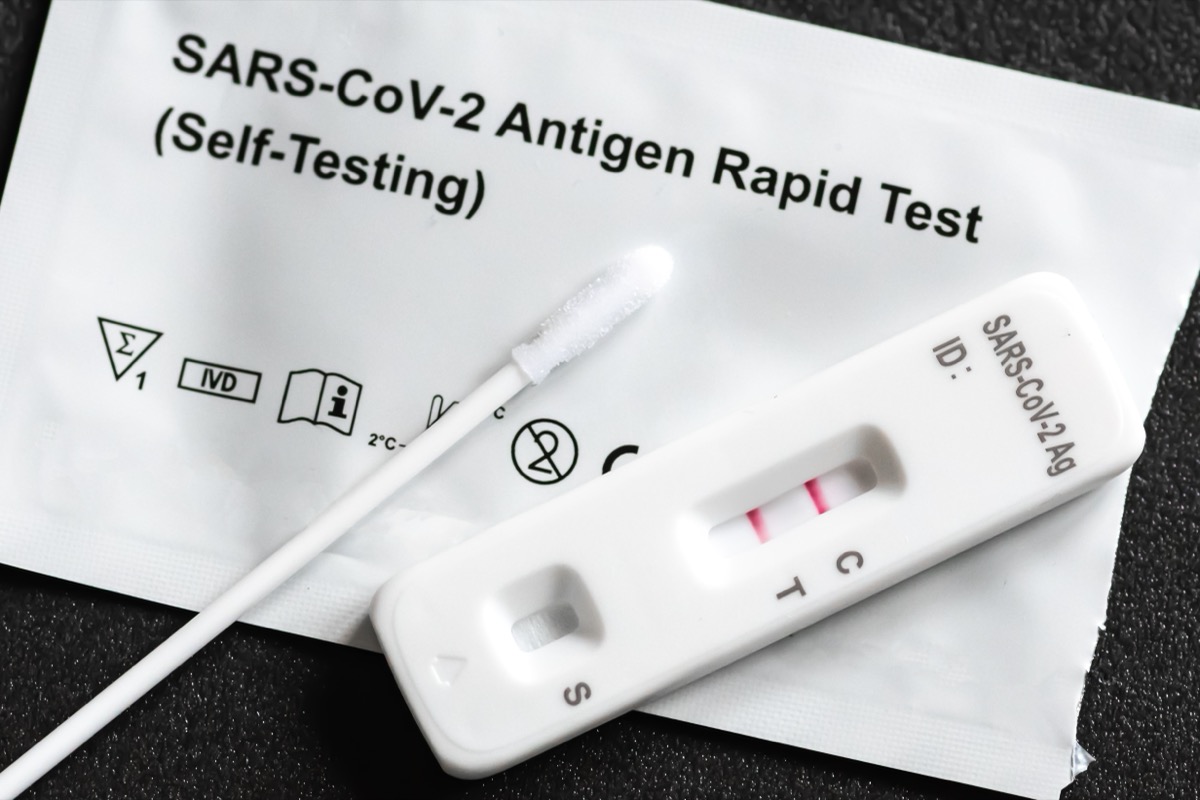How to Tell If You Have COVID, RSV or the Flu
Winter brings plenty of fun things with it: holiday festivities, ski vacations, crackling fires—and some not-so-fun things, like runny noses and sore throats. This winter in particular, may of us are nervous about the possibility of a new COVID surge, but that’s not the only health threat medical professionals are worried about.
“We face the possibility of a tripledemic this winter, with COVID-19, flu, and respiratory syncytial virus (RSV) all circulating—and there is a risk of co-infection with more than one of these viruses,” Bradley Wasson, DO, a board-certified family physician in Arlington, Texas, tells Best Life. “The CDC reports U.S. flu hospitalizations are already the highest they’ve been in 10 years, and data also shows that RSV cases are at a two-year high.”
If you have the sniffles or a scratchy throat, you might be wondering how to tell the difference between these three viruses. Read on to find out what symptoms doctors say to watch for, when to worry, and how you can protect yourself.
READ THIS NEXT: This One Supplement Reduces Your Severe Flu Risk by 90 Percent, Study Says.

“RSV is a virus that starts out with low grade viral symptoms including congestion, cough, fever, and irritability,” Steven Goudy, MD, a pediatric ENT in Atlanta and creator of the Dr. Noze Best NozeBot, tells Best Life. “Severe symptoms typically occur after the fourth or fifth day of infection [and] include severe nasal congestion, coughing fits, wheezing, and labored breathing.”
Often thought of as something that primarily affects babies and young children, RSV is on the rise in the U.S. this season in people of all ages, The New York Times recently reported. “RSV can be very serious for infants and young children, as well as older adults,” says Wasson. “The virus can also cause pneumonia and bronchiolitis in young children. One symptom that is unique to RSV is wheezing.”
Goudy adds that while “many viruses cause fever, nasal congestion and cough, RSV can cause more significant nasal and respiratory symptoms than most viruses. Most viral infections last for five to seven days, however RSV lasts for seven to 10 days.”

While COVID cases have been dropping in recent months, as CNN reports, experts are concerned that several new variants of the virus could result in another surge this winter.
“What is likely to happen is that we have several co-circulating, semi-dominate lineages going into the winter season,” Nathan Grubaugh, an associate professor of epidemiology at the Yale School of Public Health, told CNN. The news outlet explains that “the new variants are particularly devastating for millions of Americans who have weakened immune systems.”
“Sneezing, sore throat, nasal congestion, persistent cough, and headache” are all common symptoms of the current COVID variants circulating, according to Fortune, which also notes that loss of smell is “no longer common among COVID patients.”
READ THIS NEXT: Dr. Fauci Just Gave a “Pretty Troublesome” Update on What’s Next for COVID.

With so many of us concerned about COVID and RSV surges, it’s important not to forget that the plain old flu is still quite dangerous, as well. “The flu can also cause serious complications such as stroke or pneumonia,” says Wasson. “People at the highest risk of flu-related complications include young children, pregnant people, older adults, and anyone with chronic health conditions, such as lung or heart disease, diabetes, or cancer.”
“Flu signs and symptoms usually come on suddenly,” the Centers for Disease Control (CDC) notes, listing fever, chills, cough, runny nose, muscle aches, and fatigue among the most common complaints of flu-sufferers. In October, they reported an early increase in seasonal flu activity and explained that since the U.S. saw low numbers of flu cases over the past two years, “reduced population immunity, particularly among young children who may never have had flu exposure or been vaccinated, could bring about a robust return of flu” this year.
Jodi Carter, MD, Pediatric Department Chair at District Medical Group and Valleywise Health, says that with the flu, “The time from exposure to infection is typically one to four days. In addition to cough, sneezing, sore throat, and stuffy nose, infection with influenza is also often accompanied by high fever, chills, body ache, and headache.”

Sometimes a runny nose and scratchy throat are nothing to worry about. The common cold, while certainly annoying and uncomfortable, is “relatively harmless and usually clears up by itself,” the experts at Johns Hopkins Medicine write. Carter notes that colds are “often due to a rhinovirus infection,” and says there’s usually a window of two to three days between exposure and infection. “Symptoms may include cough, low grade fever, sneezing, sore throat, and/or stuffy nose,” she says.
If you have a fever, however, it’s likely that you have more than just a cold. “A high fever is usually a sign that you are dealing with something more serious than the common cold, whether that be COVID-19, flu, or RSV,” says Wasson. “Your healthcare provider may be able to help evaluate your specific symptoms. There are also rapid point of care tests that are available to help determine if you have COVID-19, the flu, or RSV.”
Given the overlap between symptoms, those tests may be the only surefire way to determine which illness you’re suffering from. And, of course, regardless of what you’re sick with, you should monitor your condition and seek medical assistance if necessary.
“With all viruses, it’s important to be on the lookout for more serious symptoms that can indicate a need for emergency treatment, such as difficulty breathing, fast breathing, bluish color of skin or lips, dehydration, or sudden dizziness,” Wasson says.
For more health advice sent directly to your inbox, sign up for our daily newsletter.

The best way to protect yourself from illness this winter is to make sure you’re vaccinated against both the flu and COVID, says Wasson. “It’s crucial to take precautions to help prevent viruses like COVID-19 and the flu in the first place,” he explains.
“One of the best ways to protect yourself and your family is to take advantage of available preventive vaccines. For example, flu vaccines can be co-administered with COVID-19 vaccines and COVID-19 booster shots on the same day, which can help you avoid multiple appointments and multiple trips to the doctor or pharmacy,” Wasson notes.
He emphasizes the importance of getting vaccines well in advance of any travel you may have planned, explaining that “it takes up to two weeks to build immunity after a flu vaccine,” and recommends visiting NotTodayFlu.com “to locate vaccines near you and to learn more about how flu vaccines may protect you from flu and its related complications such as stroke, pneumonia, and heart attack.”
Wearing a mask in public places is still a good way to keep yourself healthy this winter, reports The New York Times. CNBC has specific mask guidance designed to help you stay safe from COVID, the flu, and RSV. And if you’re concerned that many people are no longer wearing masks, it may ease your mind to know that The New York Times says there is “plenty of evidence showing that masks protect the wearer, even when others around them are mask-free.”
" Conservative News Daily does not always share or support the views and opinions expressed here; they are just those of the writer."





Now loading...